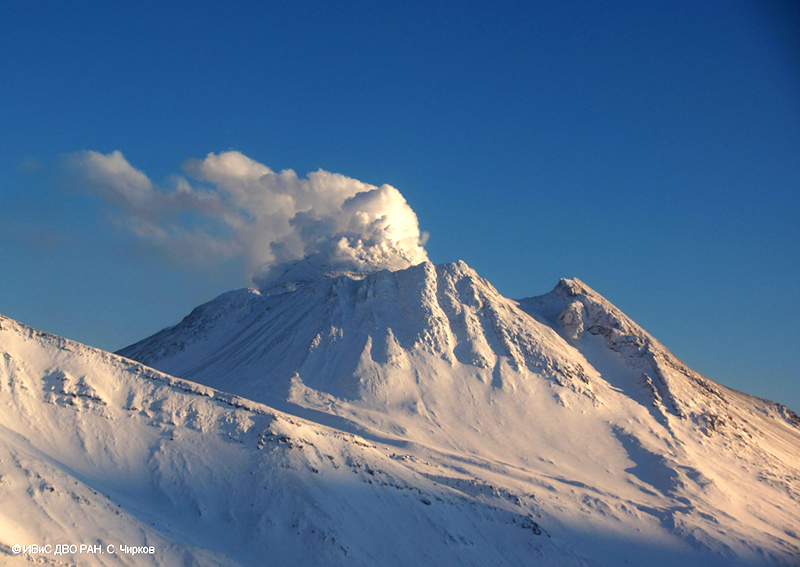Report on Bezymianny (Russia) — March 2021
Bulletin of the Global Volcanism Network, vol. 46, no. 3 (March 2021)
Managing Editor: Edward Venzke.
Edited by Kadie L. Bennis.
Bezymianny (Russia) Lava dome growth in November 2020 and continuing thermal anomalies
Please cite this report as:
Global Volcanism Program, 2021. Report on Bezymianny (Russia) (Bennis, K.L., and Venzke, E., eds.). Bulletin of the Global Volcanism Network, 46:3. Smithsonian Institution. https://doi.org/10.5479/si.GVP.BGVN202103-300250
Bezymianny
Russia
55.972°N, 160.595°E; summit elev. 2882 m
All times are local (unless otherwise noted)
Bezymianny is located on the Kamchatka Peninsula as part of the Klyuchevskoy Group of volcanoes. It has had frequent eruptions dating back to 1955; the current eruptive period began in May 2010 and recent activity has been characterized by lava dome growth, thermal anomalies, and a single ash explosion that occurred on 22 October 2020 (BGVN 45:11). This report covers similar activity during November 2020 through February 2021 primarily using weekly and daily reports from the Kamchatka Volcano Eruptions Response Team (KVERT) and satellite data.
Activity during 1-13 November 2020 was characterized by continued lava dome growth in the summit crater, accompanied by strong fumarolic activity (figure 41) and a persistent thermal anomaly over the lava dome that was visible in satellite imagery on clear weather days. The KVERT weekly reports for 6 and 12 November reported that the N flank of the lava dome was active and had possibly advanced. Continuing gas-and-steam emissions and thermal anomalies were reported by KVERT from mid-November through the end of February 2021. The volcano was often obscured by clouds, making satellite observations difficult.
 |
Figure 41. Photo of Bezymianny showing strong fumarolic activity on 8 December 2020. Photo by S. Chirkov, IVS FEB RAS. Courtesy of IVS FEB RAS, KVERT. |
The MIROVA (Middle InfraRed Observation of Volcanic Activity) volcano hotspot detection system based on the analysis of MODIS data showed relatively strong and frequent thermal anomalies during early November to early December due to the continuing lava dome growth, followed by variable, intermittent thermal activity into mid-January 2021. About four low-power anomalies were detected in mid-February (figure 42). This thermal activity was also reflected in Sentinel-2 thermal satellite imagery; thermal anomalies were observed in the summit crater over the lava dome, occasionally accompanied by white gas-and-steam emissions (figure 43).
Geological Summary. The modern Bezymianny, much smaller than its massive neighbors Kamen and Kliuchevskoi on the Kamchatka Peninsula, was formed about 4,700 years ago over a late-Pleistocene lava-dome complex and an edifice built about 11,000-7,000 years ago. Three periods of intensified activity have occurred during the past 3,000 years. The latest period, which was preceded by a 1,000-year quiescence, began with the dramatic 1955-56 eruption. This eruption, similar to that of St. Helens in 1980, produced a large open crater that was formed by collapse of the summit and an associated lateral blast. Subsequent episodic but ongoing lava-dome growth, accompanied by intermittent explosive activity and pyroclastic flows, has largely filled the 1956 crater.
Information Contacts: Kamchatka Volcanic Eruptions Response Team (KVERT), Far Eastern Branch, Russian Academy of Sciences, 9 Piip Blvd., Petropavlovsk-Kamchatsky, 683006, Russia (URL: http://www.kscnet.ru/ivs/kvert/); MIROVA (Middle InfraRed Observation of Volcanic Activity), a collaborative project between the Universities of Turin and Florence (Italy) supported by the Centre for Volcanic Risk of the Italian Civil Protection Department (URL: http://www.mirovaweb.it/); Sentinel Hub Playground (URL: https://www.sentinel-hub.com/explore/sentinel-playground).



